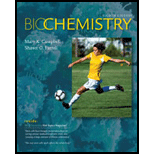
Concept explainers
RECALL State why the following terms are important in biochemistry:
Interpretation: The reason behind the importance of the terms: catalysis, protein, genetic code and polymer, is to be interpreted.
Concept Introduction: The cells constitute the fundamental units of life. Each cell has a nucleus that contains DNA (Deoxyribonucleic acid). The DNA contains genetic codes that are involved in the synthesis of proteins. Genes are expressed in the form of proteins, which make each organism different from each other. An insect and a frog express specific proteins that make their appearance different from each other. Enzymes synthesize DNA and proteins by the process of catalysis. Each DNA molecule contains a series of nucleotides, which means that DNA is a polymer of nucleotides. A protein molecule is a polymer of amino acid residues.
Answer to Problem 1RE
Solution:
Catalysis is the process of enhancing rate of reaction in the presence of a catalyst.
A protein is a polymer of amino acid residues that form the most enzymes of a cell. Different proteins get expressed in different types of organisms.
A genetic code is a segment of DNA that is involved in the synthesis of proteins that define the characteristic features of an organism.
A polymer is a large molecule that is composed of repeated units of a single type or different types of molecules, for example, DNA is a polymer of nucleotides (adenine, guanine, cytosine, and thymine). A protein is a polymer of twenty types of amino acids.
Explanation of Solution
Given information: Catalysis, protein, genetic code, and polymer.
Every organism has a unique characteristic that is stored as code inside their DNA molecules. The DNA is a long chain of nucleotides that is compacted and placed inside the small nucleus of a cell. Some of the nucleotides attain a function to transcribe into mRNA (messenger RNA), which then translates into protein. The part of DNA that is required to make proteins is called as the genetic code.
A DNA molecule have many nucleotides that are linked with each other by the phosphodiester bonds. These units are arranged in the form of polymer and make the DNA as long as 2 meters in a human nucleus. A protein molecule is also a polymer of different types of amino acids. Each amino acid is linked to the other with the help of peptide bonds.
Most proteins act as enzymes that are required to speed up the rate of the reaction. For example, the DNA polymerase is a protein required to synthesize DNA from the existing nucleotides. Without DNA polymerase, the rate of reaction would be very slow and an organism would take a long time to make a copy of its own genes. During digestion and other metabolic processes, the enzymes are required to metabolize the compounds quickly so that the cell remains safe from the toxic components. The process by which enzymes increase rate of reaction is called catalysis. Most of the enzymes are proteinaceous in nature except for certain RNAs (ribonucleic acids).
Thus, it can be concluded that the terms proteins, catalysis, genetic code, and polymer are important in biochemistry, because they are involved in various processes that are required to sustain the life of an organism.
Want to see more full solutions like this?
Chapter 1 Solutions
Biochemistry
- Do sensory neurons express ACE2 or only neurolipin-1 receptors for COVID19 virus particle binding?arrow_forwardExplain the process of CNS infiltration of COVID19 through sensory neurons from beginning to end, including processes like endocytosis, the different receptors/proteins that are involved, how they are transported and released, etc.,arrow_forwardH2C CH2 HC-COOO CH2 ܘHO-C-13c-O isocitrate C-S-COA H213c CH2 C-OO 13C-S-COA CH2 C-00 the label will not be present in succinyl CoA C-S-COA succinyl-CoAarrow_forward
- A culture of kidneys cells contains all intermediates of the citric acid cycle. It is treated with an irreversible inhibitor of malate dehydrogenase, and then infused withglucose. Fill in the following list to account for the number of energy molecules that are formed from that one molecule of glucose in this situation. (NTP = nucleotidetriphosphate, e.g., ATP or GTP)Net number of NTP:Net number of NADH:Net number of FADH2:arrow_forward16. Which one of the compounds below is the final product of the reaction sequence shown here? OH A B NaOH Zn/Hg aldol condensation heat aq. HCI acetone C 0 D Earrow_forward2. Which one of the following alkenes undergoes the least exothermic hydrogenation upon treatment with H₂/Pd? A B C D Earrow_forward
- 6. What is the IUPAC name of the following compound? A) (Z)-3,5,6-trimethyl-3,5-heptadiene B) (E)-2,3,5-trimethyl-1,4-heptadiene C) (E)-5-ethyl-2,3-dimethyl-1,5-hexadiene D) (Z)-5-ethyl-2,3-dimethyl-1,5-hexadiene E) (Z)-2,3,5-trimethyl-1,4-heptadienearrow_forwardConsider the reaction shown. CH2OH Ex. CH2 -OH CH2- Dihydroxyacetone phosphate glyceraldehyde 3-phosphate The standard free-energy change (AG) for this reaction is 7.53 kJ mol-¹. Calculate the free-energy change (AG) for this reaction at 298 K when [dihydroxyacetone phosphate] = 0.100 M and [glyceraldehyde 3-phosphate] = 0.00300 M. AG= kJ mol-1arrow_forwardIf the pH of gastric juice is 1.6, what is the amount of energy (AG) required for the transport of hydrogen ions from a cell (internal pH of 7.4) into the stomach lumen? Assume that the membrane potential across this membrane is -70.0 mV and the temperature is 37 °C. AG= kJ mol-1arrow_forward
- Consider the fatty acid structure shown. Which of the designations are accurate for this fatty acid? 17:2 (48.11) 18:2(A9.12) cis, cis-A8, A¹¹-octadecadienoate w-6 fatty acid 18:2(A6,9)arrow_forwardClassify the monosaccharides. H-C-OH H. H-C-OH H-C-OH CH₂OH H-C-OH H-C-OH H-C-OH CH₂OH CH₂OH CH₂OH CH₂OH D-erythrose D-ribose D-glyceraldehyde Dihydroxyacetone CH₂OH CH₂OH C=O Answer Bank CH₂OH C=0 HO C-H C=O H-C-OH H-C-OH pentose hexose tetrose H-C-OH H-C-OH H-C-OH aldose triose ketose CH₂OH CH₂OH CH₂OH D-erythrulose D-ribulose D-fructosearrow_forwardFatty acids are carboxylic acids with long hydrophobic tails. Draw the line-bond structure of cis-A9-hexadecenoate. Clearly show the cis-trans stereochemistry.arrow_forward
 BiochemistryBiochemistryISBN:9781305961135Author:Mary K. Campbell, Shawn O. Farrell, Owen M. McDougalPublisher:Cengage Learning
BiochemistryBiochemistryISBN:9781305961135Author:Mary K. Campbell, Shawn O. Farrell, Owen M. McDougalPublisher:Cengage Learning
